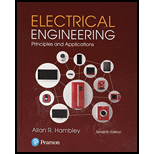
Concept explainers
A copper wire has a diameter of 2.05 mm and carries a current of 15 A due solely to electrons. (These values are common in residential wiring.) Each electron has a charge of
Trending nowThis is a popular solution!

Chapter 1 Solutions
Pearson eText for Electrical Engineering: Principles & Applications -- Instant Access (Pearson+)
Additional Engineering Textbook Solutions
Electric Circuits (10th Edition)
Basic Engineering Circuit Analysis
Electric Motors and Control Systems
Electric Circuits. (11th Edition)
Engineering Electromagnetics
Principles Of Electric Circuits
- A wire has a circular cross-section of radius r= 3.53 mm. The conductivity of the wire is 1x10^5 (Ohm, meter) and its lengthis 2m. The total resistance of the wire in Ohms is:O a. 0.51O b. 0.72ç. 0.26O d. 5136.07O e. 797497.60arrow_forwardA two wires, one of Copper and the other of Nickel, if the resistance of the first is (12.7 Q), and the second is (11.6 0) at room temperature, at what temperature are their resistances equal? Note that the temperature coefficient of resistivity of Copper is (0.0039 C-1), and for Nickel it is equal to (0.006 C1).arrow_forwardWhich of the following is not true for ferromagnetic materials? Please choose one: a. High?mthey have value. b.Above the Curie temperature, they lose their non-linear properties. C. a fixedµrthey have value. D.The energy loss is proportional to the area of the hysteresis loop.arrow_forward
- The resistance of wire increases from 40 – ohm at 20 0C to 50 – ohm at 70 0C. Find the temperature coefficient of resistance at 0 0C.arrow_forward25/ Identify the statement from the following when the inductance can have low value. a. If the number of turns of the wire is less b. If the cross-sectional area is lesser c. If the length of the wire is longer d. All the given optionsarrow_forwardP1.15. A copper wire has a diameter of 2.05 mm and carries a current of 15 A due solely to clectrons. (These values are common in residential wiring.) Each electron has a charge of -1.60 × 10-19 C. Assume that the free-electron (these are the electrons capable of moving through the copper) concentration in copper is 1029 electrons/m'. Find the average velocity of the electrons in the wire.arrow_forward
- Since an n-type semiconductor acquires a negative charge on the material, the majority has electrons as a carrier.Please choose one: a.False b.Rightarrow_forward15. Which of the following is TRUE? a. A conductor has a large amount of energy gap between conduction band and valance band b. A semi-conductor material does not allow the flow of electrons at all time. c. A good insulator material has 8 valance electrons d. A good conductor material has 3 valance electrons.arrow_forward8. Liquids with solid impurities a) Have higher dielectrie strength b) Of large size have higher dielectric strength c) Have lower dielectric strength as compared to pure liquids d) None of the above 9. Peak to peak ripple is defined as a) the difference between average de voltage and peak value b) the difference between maximum and minimum de voltage c) the difference between maximum ac and average dc voltages d) the difference between ac (rms) and average de voltages 10. In a Cockroft-Walton circuit, input voltage 100 kV load current 25 mA, supply frequency 100 Hz, each capacitor 10 nF. The optimum no. of stages for maximum output voltage is a) 1 b) 2 c) 10 d) 35arrow_forward
- b. A piece of pencil lead is connected in series with an ammeter and a power supply. The power supply is turned on. After a few minutes, although the potential difference across the pencil lead does not change, the current in the circuit increases significantly. Explain why the current increases. c. Electric fields are caused by both point charges and by parallel plates with a potential difference across them. Describe the difference between the electric field caused by a point charge and the electric field between parallel plates. Your answer should include a diagram of each type of field and reference to electric field strength. Question 2arrow_forwardA copper wire has a diameter of 2.05 mm and carries a current of 15 A due solely toelectrons. (These values are common in residential wiring.) Each electron has a charge of -1.60 x 10-19 C. Assume that the free-electron (these are the electrons capable of movingthrough the copper) concentration in copper is 1029 electrons/m³. Find the average velocity ofthe electrons in the wire.arrow_forwardAn 18-gauge copper wire with a diameter of 1-mm carries a constant current of 1-A. The charge concentration in the wire is 8.5 x 1028 per cubic meter. Determine the electric field in mN/C. Use q = 1.602 x 10-19 and resistivity equal to 1.72x10-8 ohm-m.arrow_forward
 Electricity for Refrigeration, Heating, and Air C...Mechanical EngineeringISBN:9781337399128Author:Russell E. SmithPublisher:Cengage Learning
Electricity for Refrigeration, Heating, and Air C...Mechanical EngineeringISBN:9781337399128Author:Russell E. SmithPublisher:Cengage Learning
